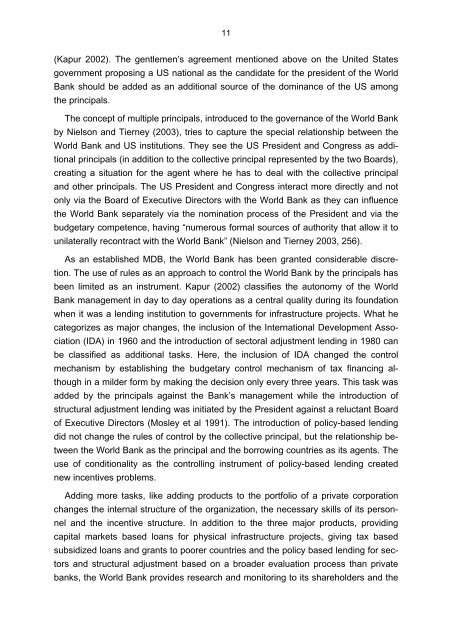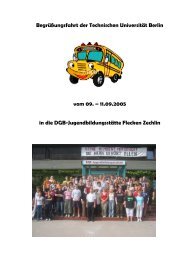Elegantes Telefax - JAV der TUB - TU Berlin
Elegantes Telefax - JAV der TUB - TU Berlin
Elegantes Telefax - JAV der TUB - TU Berlin
You also want an ePaper? Increase the reach of your titles
YUMPU automatically turns print PDFs into web optimized ePapers that Google loves.
11<br />
(Kapur 2002). The gentlemen’s agreement mentioned above on the United States<br />
government proposing a US national as the candidate for the president of the World<br />
Bank should be added as an additional source of the dominance of the US among<br />
the principals.<br />
The concept of multiple principals, introduced to the governance of the World Bank<br />
by Nielson and Tierney (2003), tries to capture the special relationship between the<br />
World Bank and US institutions. They see the US President and Congress as additional<br />
principals (in addition to the collective principal represented by the two Boards),<br />
creating a situation for the agent where he has to deal with the collective principal<br />
and other principals. The US President and Congress interact more directly and not<br />
only via the Board of Executive Directors with the World Bank as they can influence<br />
the World Bank separately via the nomination process of the President and via the<br />
budgetary competence, having “numerous formal sources of authority that allow it to<br />
unilaterally recontract with the World Bank” (Nielson and Tierney 2003, 256).<br />
As an established MDB, the World Bank has been granted consi<strong>der</strong>able discretion.<br />
The use of rules as an approach to control the World Bank by the principals has<br />
been limited as an instrument. Kapur (2002) classifies the autonomy of the World<br />
Bank management in day to day operations as a central quality during its foundation<br />
when it was a lending institution to governments for infrastructure projects. What he<br />
categorizes as major changes, the inclusion of the International Development Association<br />
(IDA) in 1960 and the introduction of sectoral adjustment lending in 1980 can<br />
be classified as additional tasks. Here, the inclusion of IDA changed the control<br />
mechanism by establishing the budgetary control mechanism of tax financing although<br />
in a mil<strong>der</strong> form by making the decision only every three years. This task was<br />
added by the principals against the Bank’s management while the introduction of<br />
structural adjustment lending was initiated by the President against a reluctant Board<br />
of Executive Directors (Mosley et al 1991). The introduction of policy-based lending<br />
did not change the rules of control by the collective principal, but the relationship between<br />
the World Bank as the principal and the borrowing countries as its agents. The<br />
use of conditionality as the controlling instrument of policy-based lending created<br />
new incentives problems.<br />
Adding more tasks, like adding products to the portfolio of a private corporation<br />
changes the internal structure of the organization, the necessary skills of its personnel<br />
and the incentive structure. In addition to the three major products, providing<br />
capital markets based loans for physical infrastructure projects, giving tax based<br />
subsidized loans and grants to poorer countries and the policy based lending for sectors<br />
and structural adjustment based on a broa<strong>der</strong> evaluation process than private<br />
banks, the World Bank provides research and monitoring to its sharehol<strong>der</strong>s and the





